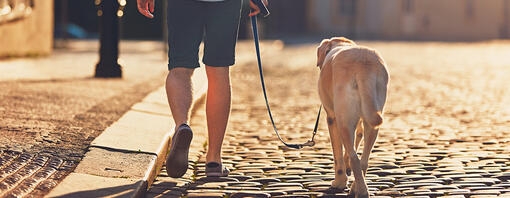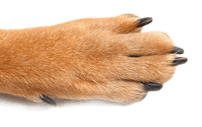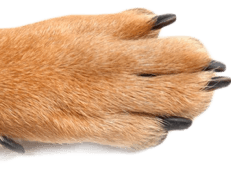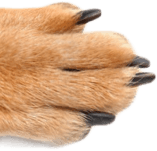
Discover how to teach your dog to walk on a loose lead in a simple step by step guide. Learn all about the equipment you will need, how to get started, and how to make sure your dog can walk on a loose lead when out and about.
There’s little more frustrating than a dog who won’t stop pulling on the lead. It can be extremely tiring for both you and your pup, can become dangerous or even cause lasting damage, and can turn a simple walk into a complete nightmare.
Due to their excitement to get places, their joy of being in the great outdoors, that they naturally walk faster than we do, and thrill of having another adventure, many dogs pull on the lead.
While every dog can get excited at times, if your dog can’t walk without constantly pulling, it means that instead of you being able to walk with them happily staying beside you on a loose lead, you are controlling them with nothing more than physical restraint.
The lead should be there for safety, and it is your training that should keep your dog walking close to you – not be something you have to hang on to with all your strength!
If you are relying on the lead, the physical effort involved in controlling your dog could be overwhelming – and even get dangerous for you both, especially if your canine friend is one of the larger, stronger breeds.
Teaching your dog to walk on a loose lead isn’t difficult – especially if you start when your dog is a puppy – and with a bit of work and a lot of consistency, you can both look forward to a lifetime of fun, enjoyable walks together.
Why is loose lead training important
Exercise
Being able to walk your puppy on a lead provides an opportunity to exercise your dog and keep them fit and healthy while they grow and mature, and throughout your life together. Many behaviour problems can be solved or reduced by making sure your dog gets enough appropriate exercise.
Mental stimulation
Exposing your puppy to new sights, sounds, smells and environments is essential to their socialisation, growth and development, and so walking on a lead is essential to exploring all these new places together.
Most dogs spend long periods of time in the home – and that can get boring! Walks are the perfect time to experience new sights, sounds, scents and environments. They break up the day in an exciting way – and one where they get to spend quality time with you too. Puppies need all kinds of positive experiences to help them develop into well-balanced dogs who are happy with all the things they will encounter in their day-to-day life. Exposing your puppy to new environments is important to their growth and development, and as they need to be safe and under control at all times, walking on a lead is essential for this.
Safety
There are many places you will want to go with your dog where having them on a lead will mean you can keep them safe – and other places where it will be important to keep people, other dogs, and livestock safe from your dog.
Further training
All the exercises you will to do – sit, down, wait, come etc – will all need to be taught outside in the real world as well as at home or in the garden. Having a dog who will walk calmly on the lead gives you the opportunity to do this as part of your ongoing training.
A dog who has been trained to properly will, as part of that training, check in with you frequently and so will listen to you far more than if they spent all their time straining on the lead and largely ignoring you.
Social responsibility
When you are out and about with your dog, you owe it to others to be in control and not have an unruly dog (however friendly or cute you think they are) charging over to other dogs or people. This means that there are going to be times, even in safe open spaces, that your dog needs to be on a lead.
Livestock
Any time you are in the countryside, you need to have close control of your dog – and (especially around sheep) that means on a lead.
What equipment do you need?
A 2m long training lead the appropriate weight for your dog (and your hands)
Treats
A comfortable well-fitting harness
Next steps in loose lead walking
Once your puppy has got over the excitement of being outside and going for walks, and is happy on their harness, you can start to work a little more on your loose lead walking and reduce the amount of treats you are giving as well.
Give your puppy a couple of treats before you set off – just to focus them on you and remind them that you have ‘good stuff’.
Then start your walk.
Let your puppy take time to sniff and explore (remember this is their walk!) but mostly just walk to wherever you are planning on going.
Your aim is that the lead stays loose at all times. It doesn’t matter if your puppy isn’t right beside you, just that the lead isn’t tight.
If it gets tight (because your puppy has gone ahead or is lagging behind), stop and wait. When your puppy looks at you, call them back to you, give them a treat and keep walking. You need to be really consistent in this and teach them that they will only get somewhere by doing it on a loose lead.
If they are lagging behind because they are worried about something, give them time to observe what it is and decide it isn’t scary. Don’t drag them or force them to move.
Practise ‘Watch Me’ regularly – just so your puppy keeps their focus on you.
Start to introduce changes of direction into your walking. Do this without pulling. Get your puppy’s attention, call them to you, and as they come towards you, turn and keep walking so they follow you.
You can also do changes of speed the same way (sometimes walking faster, other times, creeping!).
Make all these changes of direction and speed, fun and a game.
Do not think of this as ‘heelwork’, just that your puppy will walk beside you without the lead being tight – even as you change direction and speed.
Reward frequently – and don’t try to do too much too soon.
Be patient
Remember that walking on a lead is a new experience for your puppy and, for this reason, it’s important to be patient and to remember that this is an exercise that will take months to fully learn and will be an ongoing process, and it’s not something that can be taught in a few hours.
For a dog the world is an exciting place, a lead isn’t natural, and there are lots of things to do and to investigate – and so there will be plenty of slip-ups along the way.
Just stay calm, don’t be tempted to pull or tug on the lead yourself, and resist the temptation to think ‘oh it won’t matter if I let them pull today’ (especially if you are in a hurry!). Your dog has to believe that they won’t get anywhere on a tight lead.
Consistency is key – and remember it takes two to pull!
Remember: the object of lead training is that your dog will walk on a loose lead – forget about obedience style ‘heel work’ as this is an advanced exercise, usually done competitively for short periods of time, as it is unnatural for a dog and often physically tiring.




